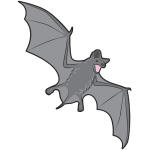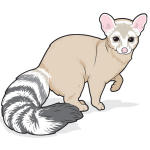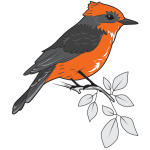Illustrations by Chris Philpot.
CARLSBAD CAVERNS NATIONAL PARK’S MOST FAMOUS RESIDENTS are its Brazilian free-tailed bats, but they’re just one of more than 67 mammals and 368 bird species that live in the mix of Chihuahuan Desert, piñon-juniper woodlands, and grasslands. Here are a few to look out for on your next visit.
BATS
 As many as half a million bats spend summers at Carlsbad Caverns, arriving in late March and staying until October. But of the 17 species known to reside here, only three roost inside the caverns. Brazilian free-tailed bats, sometimes 400,000 strong, form the largest colony. Nestled away from predators, they share body heat and can raise the air temperature in the cave from a brisk 59 degrees to a balmy 95, says Valerie Morgan, who works on the park’s biology team. When dangling females give birth, they catch their young in a basket of wing membranes. After their crowd-pleasing launch out of the bat cave at dusk, they head to southern New Mexico’s fields, where they feast on agricultural pests like moths and beetles. Evening programs to watch the exodus run from May to October.
As many as half a million bats spend summers at Carlsbad Caverns, arriving in late March and staying until October. But of the 17 species known to reside here, only three roost inside the caverns. Brazilian free-tailed bats, sometimes 400,000 strong, form the largest colony. Nestled away from predators, they share body heat and can raise the air temperature in the cave from a brisk 59 degrees to a balmy 95, says Valerie Morgan, who works on the park’s biology team. When dangling females give birth, they catch their young in a basket of wing membranes. After their crowd-pleasing launch out of the bat cave at dusk, they head to southern New Mexico’s fields, where they feast on agricultural pests like moths and beetles. Evening programs to watch the exodus run from May to October.
RINGTAILS
 These almost unbearably adorable animals spend their time on the park’s cliff faces and canyon walls, in caves, and even in mineshafts. Distinguished by their long namesake black-and-white ringed tail, the pale mask around their wide eyes, and their big ears (they’re related to raccoons), these shy, mostly nocturnal creatures are seldom seen, although their tracks match a house cat’s. “I sometimes refer to them as desert ninjas,” Morgan says. “They can pretty much climb anything and be moving at a really fast rate of speed and reverse on a dime.”
These almost unbearably adorable animals spend their time on the park’s cliff faces and canyon walls, in caves, and even in mineshafts. Distinguished by their long namesake black-and-white ringed tail, the pale mask around their wide eyes, and their big ears (they’re related to raccoons), these shy, mostly nocturnal creatures are seldom seen, although their tracks match a house cat’s. “I sometimes refer to them as desert ninjas,” Morgan says. “They can pretty much climb anything and be moving at a really fast rate of speed and reverse on a dime.”
JAVELINAS
 If you see a javelina from the side, it looks like a “tank on stilettos,” says Morgan. Although they look vaguely like furred pigs, complete with a snout, the two are at best distant relatives. “When you see them head-on, you can see how their design lends toward them weaving in and out of spiny vegetation, like mesquite and cactus, and making their way in the desert with their big guard hairs.” Javelinas are often spotted solo along the park road, and they leave their mark on gnawed prickly pear pads.
If you see a javelina from the side, it looks like a “tank on stilettos,” says Morgan. Although they look vaguely like furred pigs, complete with a snout, the two are at best distant relatives. “When you see them head-on, you can see how their design lends toward them weaving in and out of spiny vegetation, like mesquite and cactus, and making their way in the desert with their big guard hairs.” Javelinas are often spotted solo along the park road, and they leave their mark on gnawed prickly pear pads.
TEXAS HORNED LIZARDS
 On the trail from the visitor center to the natural entrance, scan the ground for these flat-bodied creatures with a pair of horns on their head. “They’re cute little critters, and closely connected with the harvester ants,” Morgan explains. Connected how? “They eat them.” That same path takes you by prime places to spot whiptail lizards—larger, longer, and sleeker than the average lizard—which are often sighted zipping into the brush.
On the trail from the visitor center to the natural entrance, scan the ground for these flat-bodied creatures with a pair of horns on their head. “They’re cute little critters, and closely connected with the harvester ants,” Morgan explains. Connected how? “They eat them.” That same path takes you by prime places to spot whiptail lizards—larger, longer, and sleeker than the average lizard—which are often sighted zipping into the brush.
BLACK-TAILED RATTLESNAKES
 The Chihuahuan Desert houses several snake species, including these predators, which help keep rodent populations in check and ecosystems in balance. Morgan points to a beautiful pattern on the black-tailed rattlesnake that culminates in its namesake ebony tip. “Oftentimes, people are probably passing rattlesnakes without even knowing that they’re there,” she says, noting that the snakes often find shelter in the sotol, a yucca species. “They’re not going to typically strike unless they’re in danger or perceive that they’re in danger.”
The Chihuahuan Desert houses several snake species, including these predators, which help keep rodent populations in check and ecosystems in balance. Morgan points to a beautiful pattern on the black-tailed rattlesnake that culminates in its namesake ebony tip. “Oftentimes, people are probably passing rattlesnakes without even knowing that they’re there,” she says, noting that the snakes often find shelter in the sotol, a yucca species. “They’re not going to typically strike unless they’re in danger or perceive that they’re in danger.”
MIGRATORY BIRDS
 Rattlesnake Springs, a picnic site where tables nestle under huge cottonwood trees planted in 1946, holds a pond spotted with turtles and fish, a former park ranger residence, a pump house, and a birding hot spot in a desert oasis. The springs are a half hour’s drive down the escarpment and south along it. Migrating songbirds, which winter in the tropics and then fly north to summer breeding grounds, begin appearing in April. Watch for vermilion flycatchers, with their bold red breast, as well as summer tanagers, varied buntings, painted buntings, and orchard orioles. “Vermilion flycatchers are out in so much abundance, you can see them almost every time you go down there,” Morgan says.
Rattlesnake Springs, a picnic site where tables nestle under huge cottonwood trees planted in 1946, holds a pond spotted with turtles and fish, a former park ranger residence, a pump house, and a birding hot spot in a desert oasis. The springs are a half hour’s drive down the escarpment and south along it. Migrating songbirds, which winter in the tropics and then fly north to summer breeding grounds, begin appearing in April. Watch for vermilion flycatchers, with their bold red breast, as well as summer tanagers, varied buntings, painted buntings, and orchard orioles. “Vermilion flycatchers are out in so much abundance, you can see them almost every time you go down there,” Morgan says.


